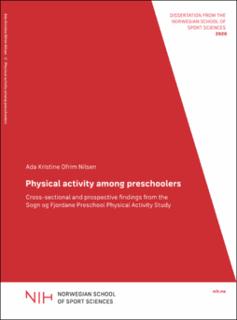| dc.contributor.author | Nilsen, Ada Kristine Ofrim | |
| dc.date.accessioned | 2020-06-04T10:16:25Z | |
| dc.date.available | 2020-06-04T10:16:25Z | |
| dc.date.issued | 2020 | |
| dc.identifier.isbn | 978-82-502-0578-9 | |
| dc.identifier.uri | https://hdl.handle.net/11250/2656521 | |
| dc.description | Avhandling (doktorgrad) - Norges idrettshøgskole, 2020 | en_US |
| dc.description.abstract | Introduction: Physical activity (PA) during early childhood is of great importance for children’s health and development. As PA levels are known to decrease over time in school-aged children and adolescents, the preschool years have been highlighted as a crucial period for establishing adequate levels of PA. However, evidence suggests that many preschoolers are not sufficiently physically active. Before interventions aiming to increase PA can be initiated, observational research is required to identify factors influencing PA behaviours among preschoolers, including how PA varies and develops by individual characteristics such as sex, age, and fundamental motor skills (FMS), and varies by environmental factors, such as season and setting. Moreover, to understand prevalence rates of PA across borders, large studies are needed from a wide range of countries. Currently, no large-scale study has determined PA objectively in Norwegian preschoolers.
Aims: The aims of this thesis was to increase knowledge about PA levels among Norwegian preschoolers; to investigate cross-sectional associations between PA and sex, age, season, setting (i.e., preschool hours vs. time out of care) and FMS; and investigate bi-directional, prospective associations between PA and FMS development.
Participants and methods: This thesis was based on the ‘Sogn og Fjordane Preschool Physical Activity Study’ (PRESPAS) conducted in 2015-2016 (cross-sectional data) and 2017 (longitudinal data), and included in total 68 preschools and 1308 children aged 2.7-6.5 years (at baseline). For the crosssectional sample, PA and FMS were measured at one time point (2015-2016). A subsample of children (n=376) participated in three repeated measurements of PA at baseline and in one follow-up measurement (2017). For this longitudinal sample, FMS were measured one time at baseline and one time at follow-up. PA was assessed objectively by ActiGraph GT3X+ accelerometers over 14 days for each monitoring period. FMS were evaluated through a test battery inspired by the ‘Test of Gross Motor Development 3’ and the ‘Preschooler Gross Motor Quality Scale’.
Main results: Overall, children had a mean total PA (SD) of 754 (201) counts per minute. Boys were consistently more active and less sedentary than girls, and PA increased with age for both sexes – although boys exhibited a greater increase than girls in moderate-to-vigorous PA (MVPA) over time. MVPA varied by season, being highest during spring and summer. Boys spent more time in MVPA during preschool hours than during time out-of-care. Boys and the oldest 50% of the children had relatively higher MVPA levels during preschool hours than girls and the younger children. The PA intensity profile associated with FMS was characterised by vigorous intensities, and the strongest association was found for FMS within the locomotor domain. Baseline MVPA predicted improved FMS two years later, but baseline FMS did not predict future PA levels.
Conclusions: Norwegian preschoolers have similar overall PA levels as to the international mean, with a potential to increase MVPA, and thus, achievement of PA guidelines. Our results show that the preschool arena is important for children’s MVPA. However, our findings indicate that this environment most successfully stimulates boys, older children, and highly active children. The results further suggest that young children should spend time in MVPA to improve their FMS. It is, therefore, essential that PA programmes and social and physical environments, including preschools, are suited to provide movement opportunities for all children to increase their PA levels and improve their FMS. | en_US |
| dc.language.iso | eng | en_US |
| dc.relation.haspart | Paper I: Nilsen, AKO; Anderssen; SA; Ylvisaaker, E; Johannessen, K; Aadland, E. Physical activity among Norwegian preschoolers varies by sex, age, and season. Scand J Med Sci Sports. 2019:29 (6);862-873. DOI: 10.1111/sms.13405. | en_US |
| dc.relation.haspart | Paper II: Nilsen, AKO; Anderssen; SA, Resaland, GK; Johannessen, K; Ylvisaaker, E; Aadland, E. Boys, older children, and highly active children benefit most from the preschool arena regarding moderate-tovigorous physical activity: a cross-sectional study of Norwegian preschoolers. Prev Med Rep. 2019;14:100837. DOI: 10.1016/j.pmedr.2019.100837. | en_US |
| dc.relation.haspart | Paper III: Nilsen, AKO; Anderssen; SA, Loftesnes, JM; Johannessen, K; Ylvisaaker, E; Aadland, E. The multivariate physical activity signature associated with gross motor skills in pre-schoolers. J Sports Sci. 2019:1-9. DOI: 10.1080/02640414.2019.1694128. | en_US |
| dc.relation.haspart | Paper IV: Nilsen, AKO; Anderssen, SA; Johannessen, K; Aadland, KN; Ylvisaaker, E; Loftesnes, JM; Aadland, E. Bidirectional prospective associations between objectively measured physical activity and fundamental motor skills in children: a two-year follow-up. Int J Behav Nutr Phys Act. 2020;17(1):1. DOI: 10.1186/s12966-019-0902-6. | en_US |
| dc.subject | accelerometer | en_US |
| dc.subject | associations | en_US |
| dc.subject | behaviour | en_US |
| dc.subject | children | en_US |
| dc.subject | development | en_US |
| dc.subject | epidemiology | en_US |
| dc.subject | fundamental motor skills | en_US |
| dc.subject | kindergarten | en_US |
| dc.subject | motor competence | en_US |
| dc.subject | physical activity | en_US |
| dc.subject | prediction | en_US |
| dc.subject | preschoolers | en_US |
| dc.subject | public health | en_US |
| dc.subject | reciprocal relationships | en_US |
| dc.subject | fysisk aktivitet | |
| dc.subject | barnehagebarn | |
| dc.subject | nih | |
| dc.subject | doktoravhandlinger | |
| dc.title | Physical activity among preschoolers : Cross-sectional and prospective findings from the Sogn og Fjordane Preschool Physical Activity Study | en_US |
| dc.type | Doctoral thesis | en_US |
| dc.description.localcode | Institutt for idrettsmedisinske dag / Department of Sports Medicine | en_US |
